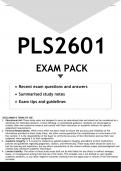PLS2601
EXAM PACK
Recent exam questions and answers
Summarised study notes
Exam tips and guidelines
DISCLAIMER & TERMS OF USE
1. Educational Aid: These study notes are designed to serve as educational aids and should not be considered as a
substitute for individual research, critical thinking, or professional guidance. Students are encouraged to
conduct their own extensive research and consult with their instructors or academic advisors for specific
assignment requirements.
2. Personal Responsibility: While every effort has been made to ensure the accuracy and reliability of the
information provided in these study notes, the seller cannot guarantee the completeness or correctness of all
the content. It is the responsibility of the buyer to verify the accuracy of the information and use their own
judgment when applying it to their assignments.
3. Academic Integrity: It is crucial for students to uphold academic integrity and adhere to their institution's
policies and guidelines regarding plagiarism, citation, and referencing. These study notes should be used as a
tool for learning and inspiration, but any direct reproduction of the content without proper acknowledgment and
citation may constitute academic misconduct.
4. Limited Liability: The seller of these study notes shall not be held liable for any direct or indirect damages,
losses, or consequences arising from the use of the notes. This includes, but is not limited to, poor grades,
academic penalties, or any other negative outcomes resulting from the application or misuse of the information
provided.
,UNIVERSITY EXAMINATIONS
MAY/JUNE 2023
PLS2601
Critical Reasoning
60 Marks
Duration 3 Hours
This paper consists of 5 pages.
Instructions:
1) This is a “take home” examination. It comprises of 5 pages including the cover. There are 3 questions
to answer (Questions 1 to 3). You have 3 hours to complete it.
2) This is also an open book exam. You can consult all of your study material.
3) Please Note: This exam is invigilated on the Invigilator App.
4) Ensure that you follow the individual instructions given for each question.
5) Number your answers correctly.
6) If possible, please type your examination. Otherwise, handwritten answers must be scanned into a
pdf file and be legible.
7) Please submit only one version of your examination script, which should be one document only.
, The text for the declaration should be as follows:
ACADEMIC HONESTY DECLARATION
1. I understand what academic dishonesty entails and am aware of Unisa’s policies in this regard.
2. I declare that this “take home examination” is my own, original work.
3. I have not allowed, and will not allow, anyone to copy my work with the intention of passing it off as
his or her own work.
4. I did not make use of another student’s work and submitted it as my own.
NAME: …………………………………………………………………………....
SIGNATURE: …………………………………………………………………....
STUDENT NUMBER: …………………………………………………………..
DATE: …………………………………………………………………………….
QUESTION 1: SHORT QUESTIONS:
Instructions for Question 1:
Write short answers for each question. The number in brackets alongside each question is the
total mark for the question.
1.1 From your study of this module, what do you understand by term ‘critical reasoning’? [3-4
sentences] (2 marks)
1.2 Describe briefly [3-4 sentences] the difference between the ‘modus ponens’ and ‘modus
tollens’ arguments? Give one example for each of the fallacies in the following format:
if P then Q,
P
Therefore Q (4 marks)
1.3 What is the difference between a premise and a conclusion of an argument? Give an
example of an argument in which you can show where the premise(s) and the conclusion
are. (4 marks)
1.4 State the kind of writing found in each of the following statements:
1.4.1 “Construct and label a truth-table to test the validity and soundness of the arguments
provided below.” (2 marks)
2
, 1.4.2 “Well, I think what it comes down to is this”, says Vusi. “Either you allow the police to use
whatever force they find necessary, or the criminals will take over this country. Now you
certainly don’t want that to happen, do you?” (2 marks)
1.5 What kind of definitions are in each of the following statements?
1.5.1 ‘Diffident’ means lacking confidence in oneself; characterised by modest reserve. (2 marks)
1.5.2 A ‘politician’ is a person of unquestioned honesty and integrity whom the people in their
collective wisdom, have duly elected to guide the ship of state and protect it from the reefs
and shoals that threaten it on every side. (2 marks)
1.6 State whether the following pieces of writings are grammatical sentences or logical
propositions (statements).
1.6.1 Aluminium is attacked by hydrochloric acid. (2 marks)
1.6.2 Let’s go to the park today! (2 marks)
1.6.3 What is the atomic weight of carbon? (2 marks)
1.6.4 South Africa is an African country. (2 marks)
1.6.5 Turn to the left at the next corner! (2 marks)
1.7 Identify a conclusion in each of the following arguments:
1.7.1 Some metals are rare and costly substances, but no welder’s materials are nonmetals;
hence some welder’s materials are rare and costly substances. (2 marks)
1.7.2 Total pacifism might be a good principle if everyone were to follow it. But not everyone
does. So, it isn’t. (2 marks)
1.7.3 Waging war is always wrong because it involves killing human beings. And killing human
beings is wrong. (2 marks)
[34]
QUESTION 2: ARGUMENT EVALUATION:
Instructions for Question 2:
1. Evaluate the following three arguments.
2. In your evaluation, state whether the argument is inductive or deductive, value or empirical,
contains a fallacy or not (stipulate which fallacy if it contains one) and whether it is valid/invalid or
sound/unsound or strong/weak.
3




